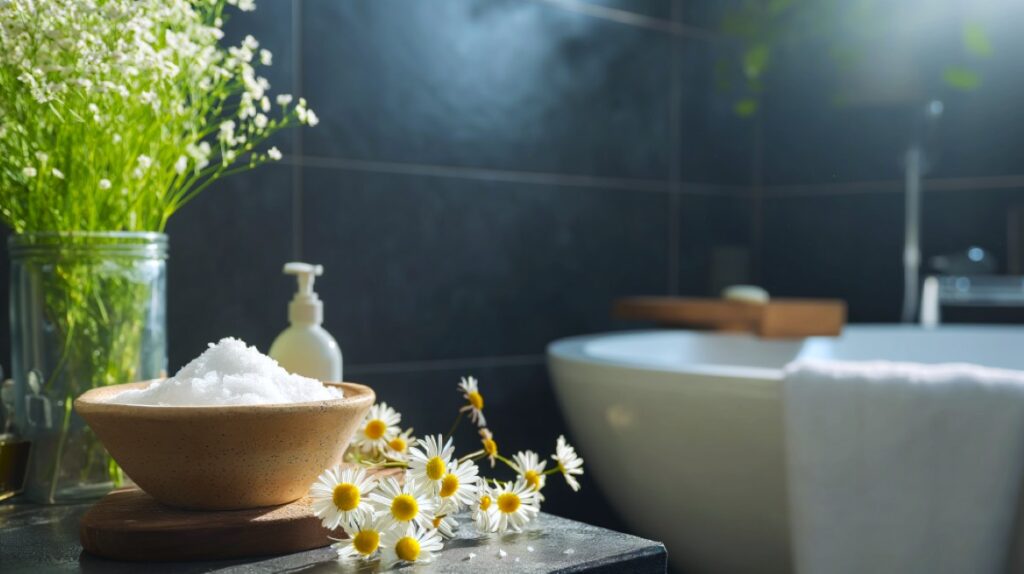13+ Uses for Epsom Salt: Practical Tips and DIY Recipes
Epsom salt, a crystalline substance rich in magnesium and sulfate, has been a trusted household staple for generations. Its uses extend far beyond the commonly known post-workout soak.
We’ve used Epsom salt in our family for many applications, including to relax muscles after a strenuous day. But it’s also a key ingredient in homemade bath bombs and bath powder.
- Discover the versatility of Epsom salt in your daily life, from enhancing your garden’s vitality to elevating your personal care routine.
- Whether mixed into a soothing bath, applied as an exfoliant, or utilized to boost plant growth, Epsom salt can be an affordable, multi-purpose mineral compound that may help in addressing a wide array of tasks around your home.
Unlock the potential of Epsom salt and explore its myriad of common everyday uses and applications.
Epsom Salt: What is It?
It’s a substance with specific chemical properties and a rich historical context that spans centuries.
Chemical Composition
- Epsom salt is a mineral compound comprised of magnesium, sulfur, and oxygen, with the chemical formula MgSO₄·7H₂O.
- Its composition is unique because it forms hydrated magnesium sulfate crystals.
- When Epsom salt dissolves in water, it releases magnesium and sulfate ions, which can be absorbed through the skin.
When absorbed, it can provide notable benefits such as relaxation of muscles and reduction of inflammation.
Historical Background
The discovery of Epsom salt dates back to the 17th century in Epsom, England.
The water of a particular spring in the area was found to possess healing properties due to the presence of bitter-tasting magnesium sulfate.
Over time, Epsom salt has become a widely used substance, both for its health benefits and its utility in garden care, by leveraging the benefits of sulfur and magnesium for plant growth.
13+ Uses and Benefits of Epsom Salt
Now that we know what Epsom salt is and a bit about its history let’s dive into a multitude of uses and applications of this amazingly cheap and common household item.
Muscle Soreness and Exercise Recovery
Epsom salt baths are a popular recovery method for athletes and those seeking natural remedies. The magnesium ions in the bath promote muscle relaxation and aid in exercise recovery.
Soaking in an Epsom salt bath can help relieve sore muscles after strenuous workouts by facilitating quicker muscle recuperation.
This makes it a beneficial addition to many high-performance athletes’ post-exercise routines, allowing them to combat fatigue and recover faster.
- Soak Method: Dissolve 2 cups of Epsom salt in warm bathwater and soak for at least 15 minutes.
- Compress Method: A concentrated solution on a cloth can be applied directly to sore muscles for localized relief.
Soothing Bruises and Sprains
Epsom salt can help reduce swelling and alleviate pain. Applying it as a compress or in a soak can speed up your body’s natural recovery process.
- Direct Compress: Mix 2 tablespoons of Epsom salt with a cup of cold water, soak a compress, and apply to the bruised area.
- Soothing Soak: For sprains, soak the affected area in a basin of warm Epsom salt water to relieve discomfort and decrease inflammation.
Non-Exercise-Related Aches and Pains
If you’re experiencing chronic aches, pains, or inflammation unrelated to exercise, an Epsom salt soak may alleviate discomfort.
The magnesium in the salt can help to relax muscle aches and reduce swelling, contributing to recovery from muscle pain, and some sources suggest even aiding in inflammation-related conditions.
Stress and Relaxation
Epsom salt baths can significantly contribute to your relaxation and stress relief routine. Immersing yourself in a bath with Epsom salt helps soothe your body, potentially easing the mental and physical symptoms of stress.
When combined with the aromatherapy effects of essential oils, these effects are even more prominent.
Skin Exfoliation
Epsom salt is a gentle exfoliant that can make your skin feel softer and cleaner. Its granular texture gently removes dead skin cells, which may help clarify your skin’s texture and reduce the appearance of acne.
Exfoliation is only one of the many cosmetic uses of Epsom salt.
- Facial Scrub: Mix half a teaspoon of Epsom salt with your facial cleanser for a skin-smoothing scrub.
- Exfoliation: Combine Epsom salt with an emollient like coconut oil for a whole-body exfoliator, focusing on rough patches such as elbows and knees. Lightly and gently rub the mixture over rough areas, then finish with a warm bath, rinse, and apply moisturizer.
Hair Care
In hair care, Epsom salt can contribute to removing product buildup and improving hair texture, giving your hair more volume.
- Hair Volume: Use equal parts conditioner and Epsom salt, apply to your hair, let it sit for 20 minutes, then rinse to add volume.
- Remove Hairspray: A solution containing Epsom salt, lemon juice, and water can help to effectively remove hairspray residue from your hair.
Constipation
Internally, Epsom salt has been used as a laxative due to its magnesium sulfate content. When used for this purpose, medical professionals advise against using it for long-term use. Instead, improving gut health through diet and other means is recommended.
It’s imperative to follow medical advice when using Epsom salt for internal health, as improper use could have adverse effects. As always, check with your healthcare professional first.
Tile and Grout Cleaner
You can create a scrubbing paste with Epsom salt by mixing it in an equal ratio with liquid dish detergent.
This paste can then be used to tackle tough stains on tile and grout. Apply the mixture onto the tile, allow it to soak in for a few minutes, then scrub away and rinse.
Anti-Microbial Hand Soap
Epsom salt can also be used in homemade hand washes to aid in removing dirt and bacteria, ensuring your hands are clean without the harshness of chemical soaps. We’ll provide a recipe for this in the section below!
Gardening Applications
Epsom salt plays a critical role in the garden, especially for plants that like higher levels of magnesium.
When it comes to soil, it works as a natural soil amendment that can enhance the nutrient uptake of plants. The magnesium helps seeds germinate better and improves chlorophyll production, leading to more lush green leaves.
- For roses, Epsom salt can encourage stronger growth and more vibrant blooms. Simply sprinkle a tablespoon around the base of rose bushes once a month before watering.
- Peppers and tomatoes also benefit from Epsom salt. Using it as a foliar spray or a soil additive can result in larger, tastier yields. Adding one tablespoon per foot of plant height to the soil around these plants once per month can make a significant difference.
- Slugs can be a nuisance, but a light sprinkling of Epsom salt where these pests tread can help deter them without using harsh chemicals.
By incorporating Epsom salt into your home cleaning regime and gardening practices, you’ll leverage a natural and effective product to maintain cleanliness and promote plant health.
A Guide to Epsom Salt in Bathing and Skincare
As mentioned above, Epsom salt baths are a well-established remedy for soothing sore muscles and promoting relaxation. When dissolved in warm water, Epsom salt quickly dissolves to provide its benefits.
Preparing an Epsom Salt Bath
To experience the benefits of an Epsom salt bath, start by filling your bathtub with warm water. It’s ideal to use a temperature that is comfortable to touch without causing any discomfort.
- Fill the Tub: Aim for a warm bath that’s not overly hot to prevent skin irritation.
- Measure Epsom Salt: Generally, you can add about 2 cups of Epsom salt to a standard-sized bathtub filled with approximately 40 gallons of water.
- Dissolve Completely: Stir the bathwater until the Epsom salt is fully dissolved in water, ensuring an even distribution.
Optional: Add a relaxing essential oil like patchouli, palmarosa, lavender, or jasmine for a more therapeutic bathing experience.
Take some time, kick back, close your eyes, and let the stress melt away.
Safety and Precautions
While Epsom salt baths are generally safe, there are some precautions you should keep in mind to maintain safety:
- Check With a Physician: If you have preexisting conditions, consult your healthcare provider before using Epsom salt.
- Hydration is Key: Drink plenty of water before and after your bath to stay hydrated and support the body’s natural detox process.
- Avoid Overexposure: Limit your bath soaks to 15-20 minutes to prevent skin dryness and dehydration. Follow up with a skin moisturizer or body butter.
- Not Too Much Heat: Ensure the bath is not too hot, as extreme temperatures can stress the body rather than promote relaxation.
DIY Epsom Salt Anti-Bacterial Hand Soap Recipe
Here is a DIY recipe for natural antibacterial hand soap with Epsom salt. It uses Castile soap, vitamin E, and a careful selection of fragrant essential oils.
Ingredients:
- 3/4 cup liquid castile soap
- 1 tablespoon almond oil
- 1 teaspoon vitamin E oil
- 2 tablespoons Epsom salt
- 5 drops tea tree essential oil
- 3 drops thyme essential oil
- 5 drops lavender essential oil
Instructions:
- Add the castile soap, almond oil, vitamin E oil, and Epsom salt to a mixing bowl. Use a whisk to stir the ingredients together until fully combined.
- Next, add in the essential oils – tea tree, thyme, and lavender. The tea tree oil provides strong antibacterial properties, while the thyme adds an extra antibacterial boost. Lavender gives a nice, calming scent.
- Whisk again to distribute the essential oils evenly throughout the mixture.
- Funnel the hand soap blend into a foaming soap dispenser.
- Fill the rest of the dispenser with filtered water, leaving about 1 inch of space at the top.
- Secure the pump and shake vigorously before first use to fully mix all ingredients.
This natural hand soap contains antibacterial essential oils to help eliminate germs while keeping skin nourished with moisturizing oils. The Epsom salt will gently exfoliate and soften the skin. Shake before each use to remix. Replace contents when low.
DIY Epsom and Lavender With Colloidal Oatmeal Fizzing Bath Powder Recipe
The below recipe is for a skin-soothing fizzing bath powder. It also includes colloidal oatmeal, lavender, a hint of citrus scent, and the sweet scent of vanilla.
If you don’t have colloid oatmeal, simply add dried oats to a blender and blend until their a fine powder-like consistency. Then, use that as colloidal oatmeal. We love using oatmeal since some members of our family struggle with eczema.
Ingredients:
- 1 cup Epsom salt
- 1/4 cup baking soda
- 3 tablespoons colloidal oatmeal
- 2 tablespoons citric acid (for fizzing, optional)
- 2 tablespoons ground flaxseed
- 1 tablespoon dried lavender buds
- 5 drops lavender essential oil
- 3 drops bergamot essential oil
- 2 drops vanilla essential oil
Instructions:
- In a bowl, mix together the Epsom salt, baking soda, colloidal oatmeal, citric acid, ground flaxseed, and dried lavender buds.
- Add the lavender, bergamot, and vanilla essential oils. Stir thoroughly to distribute evenly.
- Transfer to an airtight container for storage.
- To use, scoop 1/4 cup into warm bath water and enjoy a fizzy, aromatic soak!
The citric acid allows the ingredients to fizz and dissolves when added to the bath. The combination of the nourishing ingredients, aromatic fragrances, and benefits of Epsom salt make this a skincare recipe you’ll be coming back to time and time again.
Frequently Asked Questions
In this section, you’ll find clear answers about Epsom salt’s unique applications and safety guidelines, ensuring you use it effectively and safely in various scenarios.
How can Epsom salt be used to enhance plant growth in the garden?
Epsom salt is a natural source of magnesium and can help improve plant growth when your garden soil is deficient in this nutrient. Either apply it by sprinkling it directly onto the soil or by dissolving it in water and spraying it for plants to absorb.
Are there benefits of using Epsom salt baths for muscle recovery?
Soaking in an Epsom salt bath may benefit muscle recovery by helping to relax muscle tension and alleviate soreness due to its high magnesium content. We included a bath powder recipe in the above post!
Are there any risks associated with Epsom salt soaks for particular individuals or conditions?
Individuals with certain health conditions must consult their healthcare provider before using Epsom salt soaks.
For example, those with kidney problems or pregnant women should seek medical advice as Epsom salt can alter mineral balances and may not be recommended.
What are the consequences of not rinsing off after an Epsom salt bath?
If you don’t rinse off after an Epsom salt bath, you might experience skin dryness or irritation because the salt can leave a residue. It’s advisable to rinse with fresh water to remove the salt remnants to ensure skin comfort and cleanliness.
After rinsing, use an all-body moisturizer or body butter to seal in the skin’s moisture. This moisturization step should be part of your regular skincare routine after bathing or showering.


